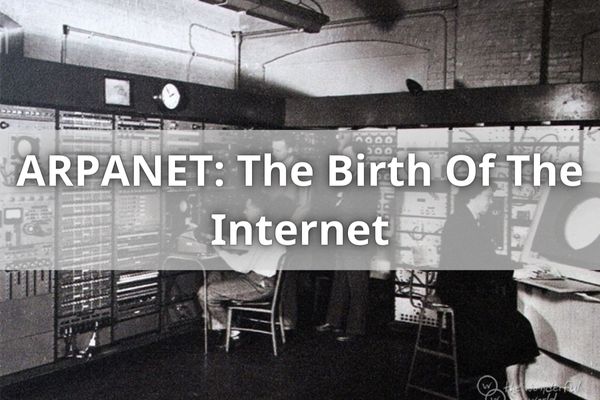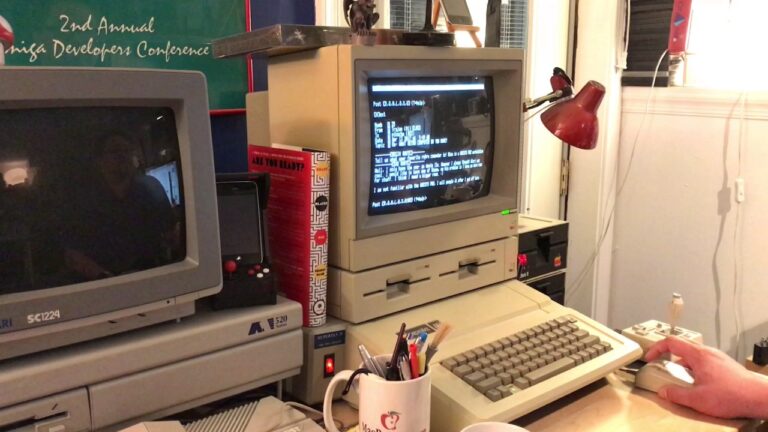The Origins Of The Internet And Its Early Development: Brief History
The Origins Of The Internet And Its Early Development. You’ve probably heard of the internet, but do you know how it first came to be or how it changed in its early years? It’s a captivating tale that significantly influenced our lives.
The invention of computers during the Cold War period is when the internet initially appeared. We’ll look at some of the significant changes that occurred throughout its early years and examine their origins in this piece.
ARPANET: The Birth Of The Internet

The internet as we know it today began with the development of ARPANET in 1969. This was a project funded by the US Department of Defense, and focused on creating a decentralized network that could survive a nuclear attack.
The basis for this system came from early research on packet switching theory which allowed information to be sent across many different networks instead of relying on one main delivery path.
In 1973, the Internet Architecture Board (IAB) was established to oversee the growth and direction of the internet. They were responsible for developing internet standards related to internet engineering and architecture task.
By 1983, local area networks had begun connecting computers all over the world, allowing them to share data faster than ever before. This marked an important milestone in the history of the internet; suddenly people had access to anyone else connected to any other computer around the globe.
As such, communication between individuals became much easier, laying down the groundwork for what would become our modern day web-based society. With more users joining each year, changes needed to be made in order to keep up with demand – thus leading us into the development of TCP/IP protocol.
The Development Of The Internet In TCP/IP Protocol
Having established the ARPANET in 1969, computer scientists and engineers continued to develop the internet technology.
The development of a protocol known as the Transmission Control Protocol and Internet Protocol (TCP/IP) was essential for creating a protocol for packet network interconnection between computers. This protocol allowed data packets to be sent from one computer to another via routers on different networks.
Vinton Cerf and Bob Kahn were two pioneers who developed the TCP/IP standards while working at ARPA in 1974. They wrote specifications specifying how data should be formatted when it is sent over a network, allowing different kinds of machines with diverse operating systems to communicate with each other.
Once this standard became widely accepted, computers could share files or access remote resources even if they weren’t part of the same physical network. The increased potential of having a common language among computers revolutionized digital communication and made way for what we now know as today’s world wide web.
The role of government funding in the emergence of the Internet is very critical. The success of TCP/IP led to its adoption by many government agencies and universities around the world, paving the way for large-scale expansion of computer networking technology. With these advancements, new possibilities began opening up regarding distributed computing capabilities which would eventually lead to powerful applications such as search engines and social media platforms that are commonplace today.
Moving forward, this paved the way for the exponential growth of the internet in global connectivity and collaboration across vast distances – setting the stage for further exploration into what lies ahead with regards to the ever-expanding world of modern day computing.
The Expansion Of The Internet
I was amazed by the expansion of the internet in its early network stages. The development of packet switching theory and local area networks made this possible.
I witnessed how the Corporation for National Research Initiatives (CNRI) and the Internet Engineering Task Force (IETF) worked together in 1983 to create more effective methods to use the internet, which fueled even further development.
The Internet Working Group was formed as a result of the IETF’s efforts, with the goal of enhancing computer networking protocols like TCP/IP to facilitate the movement of data between various computers. This new protocol allowed users from all over the world to access each other’s systems which opened up many possibilities for communication and collaboration.
It was clear that with such rapid progress, it wouldn’t be long until something big emerged from the internet’s expanding reach – and indeed it did: in 1991, Tim Berners-Lee created what we know today as the World Wide Web.
From here, there would only be more advancements as technology around us rapidly changed. As our journey into understanding these changes continues, let’s now move onto exploring how exactly they gave rise to one of history’s most powerful inventions…the World Wide Web!
The Emergence Of The Internet And The World Wide Web
As the 20th century came to a close, something revolutionary was about to take the world by storm: The World Wide Web. Starting with an idea from Tim Berners-Lee at CERN in Switzerland, this new technology soon spread around the globe and changed the way people interacted forever.
Here’s how it happened:
The first steps towards creating the web were taken at Stanford Research Institute when computers there were networked together using Interface Message Processors (IMPs) developed by Bolt, Beranek and Newman Inc. This allowed for communication between multiple machines on different continents simultaneously.
In 1985, Congress authorized funding through the National Science Foundation which led to wider public access of these networks as well as development of even more advanced technologies like hypertext transfer protocol (HTTP).
Finally, all of this effort culminated in 1989 when Tim Berners-Lee proposed what we now know as the World Wide Web. His vision combined existing tech such as HTML and HTTP into one single platform that would allow users to share information across any number of connected computers science network or devices.
By 1991, his dream had become reality – the World Wide Web had officially been born!
With its emergence, a whole new digital landscape opened up that enabled businesses to reach customers across vast distances without ever having to leave their offices; ushering in a new era of global e-commerce.
The Rise Of E-Commerce

It’s hard to imagine a world without the internet; yet, its origins and development began quite recently. The rise of e-commerce is testament to how far we’ve come in such a short amount of time.
In this section, I’ll describe some of the milestones that led us here today.
The Internet Architecture Task Force (IETF) was responsible for developing internet protocols like Transmission Control Protocol/Internet Protocol (TCP/IP), which allowed computers from different networks to exchange data effectively in 1982.
This prompted the formation of organizations dedicated to furthering the adoption of these technologies, most notably the Internet Society in 1992.
In addition, other innovations have been instrumental in making online commerce possible including Domain Name System (DNS) and Hypertext Markup Language (HTML). DNS gave every user an easy-to-remember address while HTML enabled webpages with enhanced visuals and interactivity.
Together, these inventions created the foundation for modern digital trading platforms used by millions around the globe every day.
Today’s global economy has vastly changed since those early days of the internet – one only needs to look at our reliance on social media as evidence of that transformation.
The Adoption Of Social Media
At the same time that e-commerce was on the rise, a new form of communication and connection began to take hold – social media. Starting with websites like Myspace in 2003, followed by Facebook in 2004, people were able to create profiles about themselves and connect with others through an online interface.
Social media quickly became one of the major draws for internet users all over the world:
- It allowed friends and family who moved away from each other to stay connected to the internet regardless of distance.
- It provided marketers with unprecedented access to potential customers around the globe.
- It gave everyone an outlet to express their thoughts and ideas freely with minimal censorship or oversight.
- And it created opportunities for businesses to advertise directly to their target audience without spending large amounts of money on traditional advertising methods such as print ads or television commercials.
The adoption of social media forever changed how we communicate and networked with each other; no longer limited by physical geography or technological limitations imposed by a single computer system, millions of information sources could be accessed through a global network of networks known as the Internet Engineering Task Force (IETF).
Through IETF’s Interface Message Processor protocol suite, research groups developed protocols which enabled computers to easily share data across different networks services and platforms, allowing us unparalleled access to knowledge beyond our own local communities.
This paved the way for today’s digital age where mobile technology is increasingly intertwined into our personal and professional lives – something made possible due solely to social media’s growth and proliferation throughout society.
The Growth Of Mobile Technology
My journey of uncovering the origins and early development of the internet continues with a dive into the growth of mobile technology.
This began when in 1965, Donald Davies at Britain’s National Physical Laboratory developed packet switching theory that became the foundation of data transmission over networks.
The emergence of email and its impact on communication. The first email was sent in 1971 by Ray Tomlinson using this packet switching theory which laid out a path for future developments such as Internet Technology (IT) during the 1970s.
In 1983, an organization known as the Internet Activities Board established protocols to connect computers through IT, paving a way for what is now referred to as ‘The Internet’.
As technological advances continued, so did internet engineering and architecture.
Telecommunications companies connected multiple computer network segments together forming larger networks while also extending them further across countries and continents allowing information sharing on a much wider scale than before .
With this increased connectivity came more users needing access from different locations, leading to advancements in mobile devices being able to be used with the rise of online connectivity giving rise to today’s world of ‘always-on’ accessibility.
Today it is almost impossible to imagine life without ubiquitous access via smartphones and other wireless devices however only 30 years ago these were not even part of our everyday lives.
It has been incredible to witness how far we have come since then; from inventions like packet switching theory all those decades ago right up until now – where cloud computing has revolutionized every aspect of our digital existence providing us with unprecedented levels of convenience and flexibility.
The Impact Of Cloud Computing
I had always known about the Internet and its early development but what I didn’t know was how it was really made.
Cloud Computing, Packet Switching Theory, Internet Engineering and Architecture were some of the components that enabled the internet to come into existence. The Network Measurement Center at UCLA played a huge role in this as well with two graduate students working on programming language which eventually became the foundation for cloud computing.
The core concept of packet switching theory allowed computers to communicate through small data packets across networks. A key component of the internet engineering and architecture was enabling computers to be connected together using common protocols such as TCP/IP. This has since become an integral part of both local and wide area networking technologies.
Cloud computing is now used extensively by businesses around the world due to its ability to provide reliable data storage, scalability, and cost savings compared to traditional hosting solutions. With these advantages, companies can easily access their applications from any location without having to invest in expensive hardware or software technology solutions.
Moving forward, we’ll explore how online video helped fuel the growth of modern-day digital media platforms.
The Proliferation Of Online Video

The early development of the internet is rooted in packet switching, a system that allows data to be sent between computers.
In 1969, the Internet Engineering Task Force (IETF) was created as an open forum for discussing issues related to internet architecture and configuration control. The IETF’s main focus at this time was the development of packet-switched networks which would eventually become the backbone of the modern internet.
At Bell Labs, research into packet switching began in earnest with notable contributions from Larry Roberts and Bob Taylor who were both instrumental in pushing forward its development. This team subsequently developed ARPANET – the first network to use packet switching – linking four universities together.
By 1975, there were 111 nodes on ARPANET making it one of the largest computer networks ever seen at that time.
During these early years, technological advances such as TCP/IP protocols allowed for more efficient communication over long distances than had been previously possible. With each new advance came greater potential for interconnectivity among people across vast geographical areas allowing us to come closer together through technology.
Key benefits of this period included:
- Connecting people across continents
- Enabling faster access to information
- Allowing remote collaboration on projects
This period marked an important milestone in terms of how we use technology today; however, it also signalled what was still yet to come with the emergence of the Internet of Things.
The Emergence Of The Internet Of Things
Time flew by and before we knew it, the internet had evolved from a primitive tool to something more complex – the Internet of Things. This new advancement enabled us to connect physical devices using an internet connection while still adhering to principles established by early pioneers like Vint Cerf and Bob Kahn in their design for internet governance.
It was also thanks to Leonard Kleinrock’s development of packet switching theory that allowed data packets to be exchanged between computers which set the groundwork for local area networks (LANs) and other developments such as TCP/IP protocol. The emergence of this technology made way for further advancements in internet engineering and architecture.
The idea behind the Internet of Things is simple: connect everyday objects with digital capabilities allowing them to interact with each other without any human interaction or intervention. With increased connectivity, there are myriad possibilities available when it comes to automating tasks within a home or workplace environment leading to greater efficiency and cost savings.
Furthermore, these connected smart devices can provide valuable insights into consumer behaviour through real-time tracking and analysis. These groundbreaking advances have allowed businesses all over the world to create innovative solutions that would not have been possible prior due its sheer complexity.
And although some challenges remain, such as privacy issues surrounding data collection, IoT has revolutionized how people interact with machines on a daily basis providing convenience never seen before in history. Ready now to explore what lies ahead? Let’s take a look at the future of the internet!
The Future Of The Internet

Building on the discussion of the emergence of the Internet of Things, it’s clear that these advancements have been made possible due to a number of key developments in internet technology.
In this section I’ll explore some of those events which lead to the formation and development of the modern internet as we know it today.
First, there was the development of packet switching theory by Leonard Kleinrock at UCLA in 1961-62 . This laid the groundwork for reliable communication between computers over long distances, using smaller packets instead of one big block of information.
Soon after came Theodore Hosmer’s work with ARPANET (Advanced Research Projects Agency Network) in 1969 establishing an experimental network connecting four computers across three different sites; this eventually evolved into what is now known as TCP/IP protocol – essential for all internet services.
Finally, Kleinrock went on to develop various aspects of early internet engineering and architecture including data transmission protocols which helped create a more secure environment for sending information securely between nodes or servers. These advances allowed us to move towards creating a more stable and efficient global network infrastructure underpinning much of our current online activity.
With new technological capabilities such as machine learning being integrated into existing systems, it’s no wonder why many are looking forward to see what lies ahead for our beloved web:
- Greater integration between physical devices connected via IoT networks
- Increased security measures protecting users from malicious activities
- Improved access speeds through faster networking technologies
- More accurate and powerful artificial intelligence algorithms to improve user experience.
Conclusion: The Origins Of The Internet And Its Early Development
The internet has become an integral part of our lives, and it’s important to consider the implications that this technology can bring. We need to think about the security risks associated with using the internet, as well as its impact on our daily lives, culture, and environment.
The development of the internet has also had legal ramifications which we must be aware of in order for us to stay safe online.
It is clear that looking back at the origins of the internet and its early development gives us a better appreciation of all that this technology brings to our world today.







